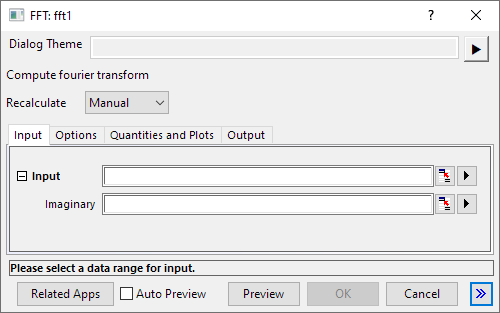18.4.1.1 The FFT Dialog BoxFFT1-Dialog

- Menu Command: Analysis: Signal Processing: FFT: FFT
- Window Types: Workbook, Graph
- X-Function Script and GUI Examples: fft1
Common Controls
Input tab
| Input
|
Specifies the input signal, which could be complex. The real and imaginary parts of the signal can be saved in different columns or in the same column. The default is <Active>, which corresponds to the active dataset.
See Specifying Your Input Data.
|
Options tab
| Sampling Interval
|
Specifies the sampling interval. The default is <Auto>, which corresponds to an automatically-computed interval. Please see the algorithm section for details.
|
| Window
|
Specifies the type of window used to suppress frequency leakage.
- Rectangle
- Welch
- Triangular
- Bartlett
- Hanning
- Hamming
- Blackman
- Gaussian
- Kaiser
For more information, see Algorithms, FFT
|
| Window Correction
|
Specifies the Window Correction Factor used to correct the alteration made by applying a window to the input data.
- None: No correction is applied.
- Amplitude: Amplitude Correction is applied. It is used when the true amplitude of narrow band data is required. The Amplitude Correction Factor is defined as
![ACF=\frac{1}{mean(w[n])} ACF=\frac{1}{mean(w[n])}](//d2mvzyuse3lwjc.cloudfront.net/doc/en/UserGuide/images/The_FFT1_Dialog_Box/math-86cf95c6418cac294454b398295ed5eb.png?v=0)
- Power: Energy Correction is applied. It is used when the true energy level of the data is required. The Power Correction Factor is defined as
![ECF=\sqrt{\frac {1}{mean(w[n]^2)}} ECF=\sqrt{\frac {1}{mean(w[n]^2)}}](//d2mvzyuse3lwjc.cloudfront.net/doc/en/UserGuide/images/The_FFT1_Dialog_Box/math-f218d600f2bcb9bc9ae2a4dbf726acb5.png?v=0)
|
| Normalize Re, Im, and Mag
|
Specifies whether to normalize the complex, real, imaginary, magnitude, and square magnitude output. The default is false. Note that other outputs such as amplitude are not affected by this variable. Please see the algorithm section for details.
|
| Shift
|
Specifies whether the result should be rearranged so that the lower frequency components are in the center.
|
| Unwrap phase
|
Specifies whether the phase should be unwrapped.
|
| Factor
|
Specifies whether the Electrical Engineering or Science convention is used to set the sign of the Exponential Phase factor.
- -1 (Electrical Engineering): The phase factor sign will be opposite to that of the Science option.
- +1 (Science): The phase factor will be set according to the formulae listed on page 503 of Numerical Recipes in C, 2nd edition.
|
| Spectrum Type
|
Specifies the Nyquist interval over which power is calculated.
- <auto>: If the input signal is real, one-sided power will be chosen; otherwise, two-sided power will be selected. When this option is selected, Origin will look at the input data to determine whether it is complex or not. If the input data is stored in a column of the Complex data type, but the data contains only a real part, Origin will regard it as real, and not as complex, resulting in a one-sided spectrum. Alternately, if the input data has an all-zero column as the imaginary part, Origin will also regard the input as real, and produce a one-sided spectrum.
- One-sided: One-sided power will be computed.
- Two-sided: Two-sided power will be computed.
|
| Normalize power to
|
Specifies the power density normalization method. Please see the algorithm section for details.
- MSA-Mean Square Amplitude: Mean square amplitude method.
- SSA-Sum Square Amplitude: Sum square amplitude method.
- TISA-Time Interval Square Amplitude': Time Integral square amplitude method.
|
| Preview
|
Specifies the preview content in the dialog.
None, Amplitude/Phase, Power/Phase, Amplitude, Imaginary, Magnitude, Phase, Power, Real, Real/Imaginary, dB, Normalized dB, RMS Amplitude, Square Amplitude , Square Magnitude
|
Quantities and Plots tab
Select check boxes to create output of the following components of the FFT results:
Real, Imag, Amplitude/Phase, Phase, Power/Phase, Real/Imag, Magnitude, Amplitude, Power, dB, Normalized dB, RMS Amplitude, Square Amplitude, Square Magnitude.
Output tab
See Output Results.
| Result Data Sheet
|
Specifies the worksheet sheet for outputting the result data.
|
| Result Graph Sheet
|
Specifies the sheet for outputting the result graphs.
|
|